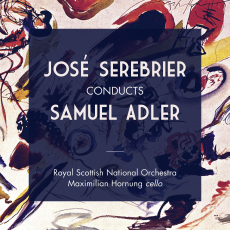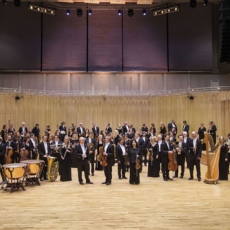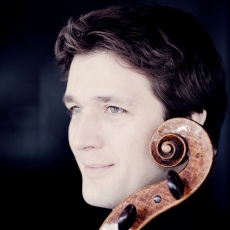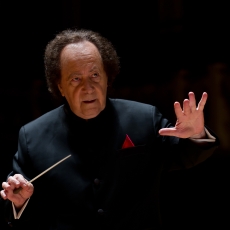RSNO - Serebrier Conducts Adler - Info Dad Blog
The definition of "contemporary" changes over time - by definition. But the notion of "modern" is a bit different. In Western music, it has to do with the sound of a piece - not the specifics of its structure or its compositional method so much as the way the composer approaches the music and the way listeners perceive it. "Contemporary" is an objective adjective, "modern" a much more subjective one. This is why Stravinsky's The Rite of Spring still seems so modern, a century after it was composed. There is something in the strangeness of the orchestration, the irregularity of the rhythms, the pounding ostinato of some sections and the instrumental screeching of others, the willingness to entice the ear for a moment and then attack it with noise the next, the frequent alterations of dynamics, the unpredictability of tempo changes, that makes this work feel unfailingly "modern" no matter how often it is played. A tour de forcefor conductors and orchestras, The Rite of Spring is also a work that inexorably pulls audiences along even though very few people have seen it as a ballet. The best performances are cognizant of the remarkable modernity of the score and go out of their way to accentuate it - and the Recursive Classics release featuring the Park Avenue Chamber Symphony under David Bernard is an exceptional one. Using a newly edited and revised version of The Right of Spring to which Bernard himself contributed, this performance brings extraordinary clarity, instrumental balance and an unending series of elegant touches to what is still a very complex score. Percussion emphases are pointed and intense, timpani penetrate the ensemble with clarity, woodwinds vary in sound from lyrical to screechy, strings run the gamut from fleet to oppressively heavy - every section of the orchestra is highly soloistic as well as incorporated into an overall sound world that is every bit as evocative as Stravinsky intended it to be. The revisions in this new edition are technical ones that will largely be inaudible to casual listeners, but anyone hearing this outstanding performance will be captivated by the enormous skill of the musicians and by Bernard's near-perfect handling of pacing, sectional contrast and overall sound. The pairing of The Rite of Springwith Bartók's Concerto for Orchestra is a particularly happy one in this case, since Bernard treats Stravinsky's work itself as a concerto for orchestra - which, listeners to this recording will realize, it is. Bernard brings the same clarity of purpose and intensity of execution to the Bartók as to the Stravinsky. The seriousness of the opening movement emerges from the first quietly emerging notes and remains throughout, making the contrast with the second, Giuoco delle coppie ("Game of Couples" - for some reason, the CD gives the translation but not the original title), all the more apparent. The multiple duets are given with a lightness and bounce that make the following Elegia all the more effective, and Bernard does a first-rate job of showing the connections between this movement's themes and those of the first movement. Then there is genuine hilarity, as well as a clear Lehár parody, in the Intermezzo interrotto (called "Interrupted intermezzo" on the CD); and the concluding perpetuum mobile, a litmus test of any orchestra's ability to play together and stay together for 10 nonstop minutes, comes across brilliantly - a genuine capstone to a remarkably fine and highly recommended performance.
The music of Samuel Adler (born 1928) partakes of both modernity and contemporaneity: the works on a new Linn Records CD are no more than 30 years old. Interestingly, although these pieces are in no way beholden to Bartók's Concerto for Orchestra, they include, to some degree, some of the same tension between traditional form and distinctly modern harmony and orchestration. Adler's Symphony No. 6 here gets its first performance as well as its first recording, and it proves to be a substantial, energy-packed three-movement work with a fine sense of instrumental balance. José Serebrier and the Royal Scottish National Orchestra make sure the first movement has plenty of headlong motion and excitement, with the result that the mysterious and rather dark second movement provides very strong contrast, its interjections of lyricism bringing a brief sense of naïveté to what is otherwise a sophisticated-sounding piece. The final movement's mood resembles that of the first, but here a primary impression - as in The Rite of Spring - is of constant rhythmic changes that sweep the listener along. The symphony as a whole is energetic and intense, if not particularly deep from an emotional standpoint; perhaps this makes it especially reflective of much of contemporary life. It is coupled here with Adler's Concerto for Cello and Orchestra, played with fine tone and musical understanding by Maximilian Hornung. This four-movement work effectively highlights the tonal beauty and virtuosic capabilities of the solo instrument, the first movement offering considerable lyricism while the second has a pleasantly jazzy and perky feel to it, notably in the use of pizzicato double basses and a drum set. The meditative, fantasia-like third movement is followed by a final rondo that well reflects its marking, Fast and playful. This fascinating CD concludes with a piece poetically titled Drifting on Winds and Currents, commissioned as an in memoriam work and offering a mixture of soothing textures with some underlying feelings of uncertainty and even anxiety. It is a short, effective tone poem whose dramatic central section only briefly disturbs the comparative calm of the opening and closing. All the works are played with skill and understanding: Serebrier seems quite comfortable with Adler's music, and the orchestra plays very well throughout.



